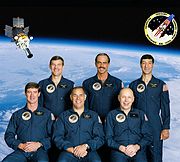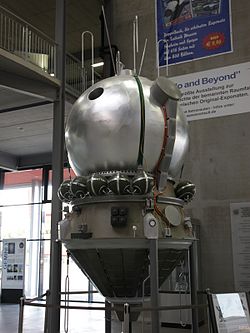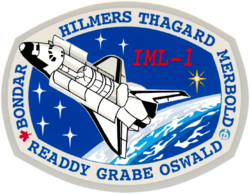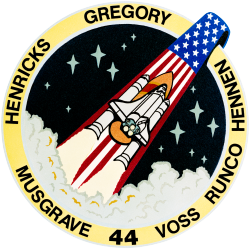STS-44
| STS-44 | |||||
 | |||||
| Uppdrag | 44 | ||||
|---|---|---|---|---|---|
| Rymdfärja | Atlantis (10)[1] | ||||
| NSSDC-ID | 1991-080A[2] | ||||
| Färdens tid | 6 dagar, 22 timmar, 50 minuter, 44 sekunder | ||||
| Uppskjutning | |||||
| Startplats | Startplatta 39A vid Kennedy Space Center i Florida | ||||
| Start | 24 november 1991, 6:44:00 p.m. EST | ||||
| Landning | |||||
| Landningsplats | Runway 5. Edwards Air Force Base, Kalifornien | ||||
| Landning | 1 december 1991, 2:34:12 p.m. PST | ||||
| Omloppsbana | |||||
| Varv | 109 st[3] | ||||
| Apogeum | 371 km | ||||
| Perigeum | 363 km | ||||
| Banlutning | 28,5° | ||||
| Sträcka | 4,651 miljoner km | ||||
| Besättning | |||||
| Befälhavare | Frederick D. Gregory (3) | ||||
| Pilot | Terence T. Henricks (1) | ||||
| Uppdragsspecialister | Story Musgrave (4) Mario Runco, Jr. (1) James S. Voss (1) | ||||
| Nyttolastspecialister | Thomas J. Hennen (1) | ||||
 | |||||
| Kronologi Rymdfärjeprogrammet | |||||
| |||||
STS-44 var den fyrtiofjärde flygningen i det amerikanska rymdfärjeprogrammet, den tionde flygningen med rymdfärjan Atlantis. Den sköts upp från Pad 39A vid Kennedy Space Center i Florida den 24 november 1991. Efter nästan sju dagar i omloppsbana runt jorden återinträdde rymdfärjan i jordens atmosfär och landade vid Edwards Air Force Base i Kalifornien.
Flygningen gjordes på uppdrag av USA:s försvarsdepartement.
Se även
Referenser
- ^ NASA Space Shuttle Launch Archive Arkiverad 27 maj 2010 hämtat från the Wayback Machine., läst 28 juli 2016.
- ^ ”NASA Space Science Data Coordinated Archive” (på engelska). NASA. https://nssdc.gsfc.nasa.gov/nmc/spacecraft/display.action?id=1991-080A. Läst 19 mars 2020.
- ^ Manned Astronautics - Figures & Facts Arkiverad 16 augusti 2016 hämtat från the Wayback Machine., läst 28 juli 2016.
Externa länkar
 Wikimedia Commons har media som rör STS-44.
Wikimedia Commons har media som rör STS-44.
| ||||||||
| ||||||||||||||||||||||||||||||||
Media som används på denna webbplats
Författare/Upphovsman: Pascal (Flickr user: pasukaru76), Licens: CC0
Vostok spacecraft replica at the Technik Museum Speyer, Germany.
The STS-44 crew portrait includes 6 astronauts. Pictured seated, from left to right, are Terence T. Hendricks, pilot; Frederick D. Gregory, commander; and F. Story Musgrave, mission specialist. Standing on the back row (left to right) are James S. Voss, mission specialist; Thomas J. Hennen, payload specialist; and Mario Runco, Jr., mission specialist. The 6 crew members launched aboard the Space Shuttle Atlantis on November 24, 1991 at 6:44:00 pm (EST). Dedicated to the Department of Defense (DOD), the mission's primary unclassified payload was the Defense Support Program (DSP) satellite and attached Inertial Upper Stage (IUS).
STS-42 Mission Insignia
STS-44 Mission Insignia
STS-48 Mission Insignia
- Designed by the astronaut crewmembers, the STS 48 patch represents the Space Shuttle Orbiter Discovery in orbit about the Earth after deploying the Upper Atmospheric Research Satellite (UARS) depicted in block letter style. The stars are those in the Northern Hemisphere as seen in the fall and winter when UARS will begin its study of Earth's atmosphere. The color bands on Earth's horizon, extending up to the UARS spacecraft, depict the study of Earth's atmosphere. The triangular shape represents the relationship among the three atmospheric processes that determine upper atmospheric structure and behavior: chemistry, dynamics and energy. In the words of the crewmembers, This continuous process brings life to our planet and makes our planet unique in the solar system."






